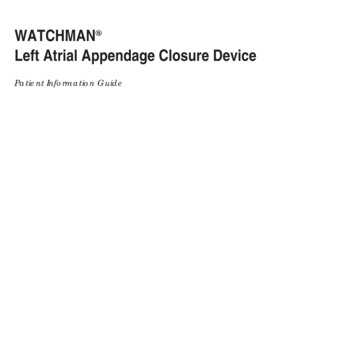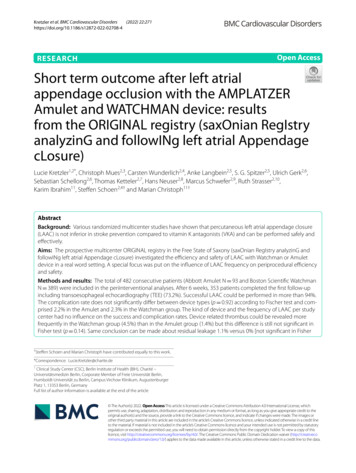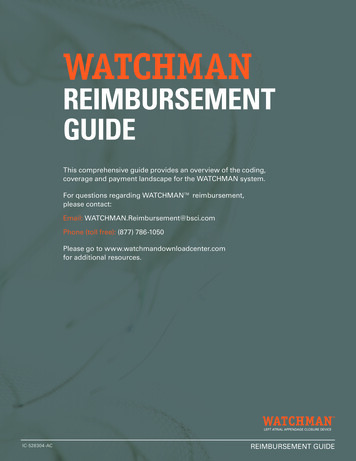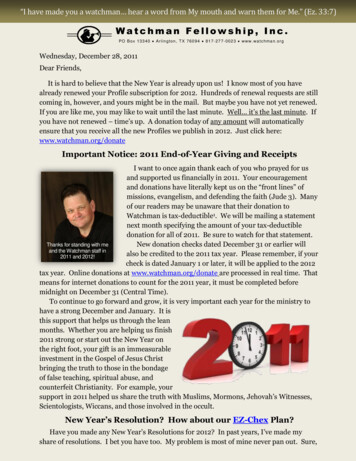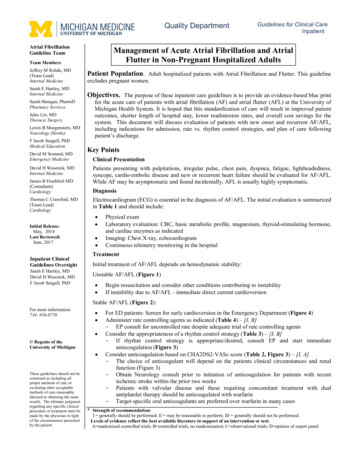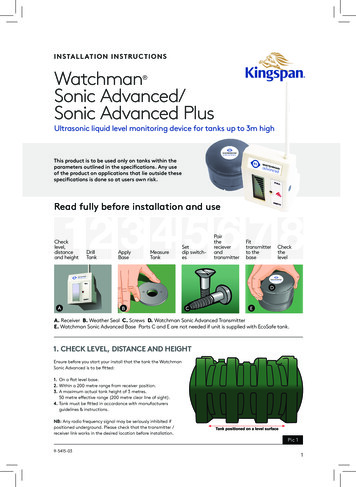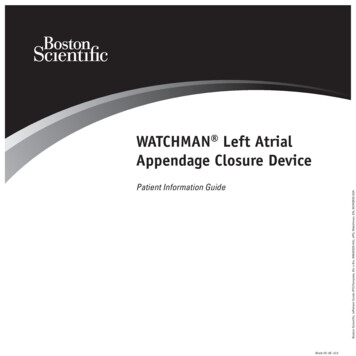
Transcription
Patient Information GuideBoston Scientific, (ePatient Guide (PG)Template, 8in x 8in, 90642526 AA), ePG, Watchman, EN, 90743933-02AWATCHMAN Left AtrialAppendage Closure DeviceBlack (K) E 5.0
WATCHMAN Left Atrial AppendageClosure DeviceLeft AtriumRight AtriumLeft Atrial Appendage withthe WATCHMAN ImplantPATIENT INFORMATION GUIDEYour doctor has recommended that you consider undergoing a procedure toreceive the WATCHMAN Implant or you have recently had a WATCHMAN Implantprocedure in a part of your heart called the left atrial appendage (LAA). Thefollowing information about the WATCHMAN Implant is important for you to knowand will address many of the common questions you may have about your implant.UNDERSTANDING YOUR HEARTThis section will discuss the basic function of the normal heart and will alsoexplain what happens when the heart develops the condition known as atrialfibrillation.Left VentricleBoston Scientific, (ePatient Guide (PG)Template, 8in x 8in, 90642526 AA), ePG, Watchman, EN, 90743933-02AThe Normal HeartRight VentricleThe heart is divided into four chambers: two upper atrial chambers (a right andleft atrium) and two lower ventricular chambers (a right and left ventricle). Thefour chambers fill with blood when the heart is at rest and then pump the bloodthroughout the body with each heart beat (or contraction).The heart has specialized cells which produce electrical impulses that stimulatethe heart muscle cells to beat and pump blood. Normally, your heart’s pumpingrate is controlled by the heart’s internal pacemaker that is located in the upperportion of the right atrium. The heart beat spreads throughout both the right atriumand left atrium and then travels through special pathways to both the right andleft ventricles. This electrical stimulation causes the heart muscle to contract andpump blood through the blood vessels. The heart then rests and fills with blooduntil the next contraction occurs. This cycle occurs millions of times in a year.A blood clot is called a “thrombus” when it is stays in one place, and if it breaksloose and travels to another part of the body, it is then called a “thromboembolus.”A thromboembolus can be dangerous if it blocks a blood vessel that suppliesblood to an important body part. If a thromboembolus breaks loose from the leftatrial appendage and blocks a blood vessel in the brain, the part of the brain that issupplied by that blood vessel can become permanently damaged within minutes.This type of brain damage is known as a stroke. A stroke can result in the loss ofa body function, weakness, a change in sensation, problems speaking, or evendeath. Besides the brain, a thromboembolus can travel to other areas of the bodyand cause organ damage by blocking blood flow.Atrial FibrillationIn atrial fibrillation, the right and left atria no longer contract together in a coordinatedfashion and the heart beat (pulse) becomes irregular. Atrial fibrillation can cause youto have symptoms such as feeling tired (fatigue), lightheaded, short of breath, or havea fluttering sensation in your chest (palpitations). It is also possible that you may haveno symptoms.Doctors often prescribe medications to prevent the pulse rate from getting too fast.These medications typically help patients feel well and able to do normal activitiesdespite having atrial fibrillation. However, despite taking these medications (or tryingthese medications) some patients still feel poorly due to atrial fibrillation and requireadditional medications or special heart procedures (known as cardioversion andablation) to try to stop atrial fibrillation altogether and keep the heart in a normalrhythm.Atrial Fibrillation, Heart Blood Clots, and the Risk of StrokeBecause right and left atria no longer contract normally in atrial fibrillation, theblood flow within the atria can be slower than normal. This change in blood flowmay also cause blood clots to form. During atrial fibrillation, most blood clots thatoriginate in the heart develop in the left atrial appendage, which is a pouch-likestructure that is part of the left atrium.2Black (K) E 5.0
Not all atrial fibrillation patients are at equal risk for developing left atrialappendage blood clots and stroke. Factors that increase the risk includeadvancing age (particularly ages greater than 75 years), high blood pressure,heart failure, diabetes, other cardiovascular (heart) disease, and a prior stroke ormini-stroke (“transient ischemic attack” or TIA).increase the risk of major bleeding episodes (including bleeding in the brain),and anticoagulant medications can usually be stopped about 6 weeks aftersuccessful placement of the WATCHMAN Implant in your heart, provided the leftatrial appendage has been adequately sealed. Your doctor will also consider yourpersonal preferences regarding anticoagulant medications and heart proceduresassociated with implanting and monitoring the WATCHMAN Implant.When a blood clot develops in the heart of a patient with atrial fibrillation, it is mostoften found within the left atrial appendage. The WATCHMAN Implant acts as abarrier to prevent left atrial appendage blood clots from entering the bloodstreamand blocking a blood vessel in the brain resulting in a stroke. However, it isimportant for you to know that a stroke can be due to factors not related to a clottraveling to the brain from the left atrial appendage. Other causes of stroke caninclude high blood pressure and narrowing of the blood vessels to the brain. TheWATCHMAN Implant will not prevent these other causes of stroke.In studies of the WATCHMAN Implant in patients with atrial fibrillation, the safetyand effectiveness of the implant has been compared to warfarin. The WATCHMANImplant has not been compared to newer anticoagulant medications that havealso been approved to lower the rate of stroke in atrial fibrillation patientsIt is also important for you to understand that, like anticoagulant medications, theWATCHMAN Implant does not cure atrial fibrillation.Be sure to discuss your specific situation with your doctor as you consider alloptions to reduce your risk of stroke.Current Treatment to Prevent Stroke in Atrial FibrillationPatientsThe current treatment for atrial fibrillation patients who are at increased risk forstroke is treatment with blood-thinning medications called anticoagulants, whichreduce the chance that blood clots form. These medications (which includewarfarin [commonly referred to as Coumadin ] and other newer approvedanticoagulants) are very effective in lowering the risk of stroke in atrial fibrillationpatients. Most patients can safely take these medications for years (and evendecades) without serious side effects.However, some patients find that anticoagulants can be difficult to tolerate orrisky. Because they prevent blood clots by thinning the blood, anticoagulantscan increase the risk of bleeding problems. When bleeding events occur, theevents are often minor (like a skin cut taking longer to stop bleeding than normal)and easily treated. But in some cases, bleeding can be quite serious requiringhospitalization and transfusion and can even be life-threatening or fatal (such aswhen strokes are caused by bleeding into the brain).When prescribing anticoagulant medications in atrial fibrillation patients, doctorsconsider the risk of a stroke versus the risk of a serious bleeding problem. Instudies of atrial fibrillation patients, the benefit of a reduced risk of stroke causedby a blood clot traveling from the left atrial appendage is greater than the riskof major bleeding (including strokes caused by bleeding into the brain). Thismeans that more strokes are prevented by anticoagulant medications than arecaused by anticoagulant medications. Therefore, anticoagulant medicationsare recommended for most patients. However, in select patients, the risk ofmajor bleeding is believed to be too high, so that anticoagulants will not beprescribed. Other atrial fibrillation patients, even though they may be able to takeanticoagulant medications without major bleeding, may choose not to take themedication because of minor bleeding episodes, other medication side effects, orconcerns about bleeding due to trauma.A patient with atrial fibrillation who currently has a blood clot in the heart shouldnot receive a WATCHMAN Implant until the blood clot is successfully treatedwith blood thinning medications. Patients who have had an atrial septal repair orclosure device should not receive the WATCHMAN Implant. Other patients whoshould not receive the implant include: Patients with a left atrial appendage that is too large or too small to fit theWATCHMAN Implant. Patients who cannot take warfarin, aspirin, or clopidogrel. Patients who should not or cannot undergo heart catheterization procedures. Patients who have an allergy or sensitivity to nitinol (nickel and titanium) orany of the other materials in the WATCHMAN Implant.Additionally, due to the upfront risk of undergoing an invasive heart procedure,patients should not be considered for the WATCHMAN Implant if they are doingwell and anticipate continuing to do well with anticoagulant medications. Ingeneral, a WATCHMAN Implant is not appropriate for those patients for whomthe risk of the implantation procedure is expected to exceed the benefit fromreceiving the implant. The WATCHMAN Implant is not recommended in patientswhose atrial fibrillation is due to significant heart valve disease.WATCHMAN LEFT ATRIAL APPENDAGE CLOSURE DEVICEThe WATCHMAN Left Atrial Appendage Closure Device is implanted at the openingof the left atrial appendage and is intended to prevent left atrial appendage bloodclots from entering your blood stream and potentially causing a stroke. It is madeof materials that are common to many medical devices. The implant is designed tobe a one-time implant that does not need to be replaced.Treatment with the WATCHMAN Implant to Prevent Stroke inAtrial Fibrillation PatientsYour doctor has prescribed the WATCHMAN Implant for you because youhave atrial fibrillation without significant heart valve disease, but with otherrisk factors that put you at an increased risk of stroke. Although you may takean anticoagulant (blood thinning medication) called warfarin to reduce the riskof stroke, your doctor has recommended that you undergo implantation of theWATCHMAN Implant as an alternative to long-term use of this drug. In makingthis recommendation, your doctor has considered the benefits and risks of theWATCHMAN Implant compared to the benefits and risks of warfarin and/or thebenefits and risks of other approved anticoagulant medication that are used toreduce the risk of stroke in atrial fibrillation patients.Among the factors you and your doctor may consider are your overall risk ofstroke, your risk of stroke caused by a blockage of a blood vessel in the brain,and your risk of a major bleeding problem while taking anticoagulant medications(including bleeding in the brain). In the case of preventing a stroke caused by ablockage of a blood vessel in the brain, anticoagulant medications may be betterthan the WATCHMAN Implant. On the other hand, anticoagulant medications3Black (K) E 5.0Boston Scientific, (ePatient Guide (PG)Template, 8in x 8in, 90642526 AA), ePG, Watchman, EN, 90743933-02APatients Who Should Not be Considered for the WATCHMANImplant
at around 6 months to re-evaluate whether adequate closure of the left atrialappendage has occurred.It is extremely important for you to take the recommended medications (warfarin,clopidogrel, and aspirin) at the recommended time. If you stop taking thesemedications or change their dosage before being instructed to do so by yourdoctor, the chances of blood clot formation, subsequent stroke, or even death areincreased. Talk to your doctor before stopping your medications or changing thedosage.If surgery or dental work is needed which would require you to stop taking thesemedications prematurely, you and your doctors should carefully consider the risksand benefits of this additional surgery or dental work versus the possible risksfrom stopping these medications early. Talk to your doctor about the timing of anymedical procedures you may need.If you do require premature discontinuation of these medications becauseof significant bleeding, your doctor will carefully monitor you for possiblecomplications. Once your condition has stabilized, your doctor may restart thesemedications. Talk to your doctor before restarting medications or changing theirdoses.Information to Consider Prior to your WATCHMAN ImplantBefore the WATCHMAN Implant, your doctor will perform a thorough assessment.He/she will ask you about your medical history, assess your stroke risk, performa physical examination, and take pictures of your heart using a technique calleda TEE (trans-esophageal echocardiogram). A thrombus inside your heart may bedetected by the TEE. A patient with atrial fibrillation who currently has a thrombuswithin the heart should not be considered for a WATCHMAN Implant until thethrombus goes away after a course of blood thinners.Your doctor will provide specific instructions on what medications to take, such asanticoagulant medications and aspirin. Be sure to discuss any medication changeswith your doctor.Boston Scientific, (ePatient Guide (PG)Template, 8in x 8in, 90642526 AA), ePG, Watchman, EN, 90743933-02AImplanting the WATCHMAN ImplantThe WATCHMAN Implant is placed into your heart using a minimally invasiveprocedure in a cardiac catheterization laboratory or electrophysiology laboratoryby a physician and his/her team who have experience and training in theWATCHMAN implantation technique. In preparation for the implant, you will belying on your back on a table while you are continuously monitored throughoutthe procedure by medical personnel. X-rays and echocardiograms (a special typeof ultrasound picture) will be used to help visualize the heart while the implant isbeing advanced into the correct position in your heart. Contrast media (dye) willalso be injected to help guide the implant placement. You will be given a generaland/or local anesthetic by your doctor to minimize any discomfort during theprocedure. Discuss the anesthesia method that is best for you with your physician.A small puncture is made into a vein in your groin. A long, thin tube, called acatheter, is inserted into the vein and advanced into the right atrium of the heart.Another puncture is made through a thin muscle wall between the right atrium andthe left atrium so that the catheter can be advanced into the left atrium. A thinnercatheter is then advanced into the left atrial appendage under X-ray guidance.The WATCHMAN Implant is tightly compressed within the catheter and is passedthrough the catheter into the left atrial appendage. The physician will make surethat the implant is in the right place within the left atrial appendage and thendeploy the implant (much like opening up a folded umbrella). After the procedure,the WATCHMAN Implant is the only material that remains in the body. A thin layerof tissue will grow over the surface of the WATCHMAN Implant within about 45days.CLINICAL STUDIESThe potential benefits of the WATCHMAN Implant for a patient with atrialfibrillation without heart valve disease are as follows: Reducing the risk of stroke from a blood clot originating in the left atrialappendage Being able to stop long-term warfarin therapy and a reduction in the risksassociated with long-term warfarin useIn the PROTECT AF study, which lasted five years and studied 707 atrial fibrillationpatients, the WATCHMAN Implant was compared to warfarin. The WATCHMANImplant was found to be as effective as warfarin in reducing the risk of thecombination of stroke (either from a blocked vessel or bleeding within thebrain), cardiovascular death, or a blocked blood vessel in another part of thebody besides the brain. A second study of the WATCHMAN Implant comparedto warfarin called the PREVAIL study enrolled 407 atrial fibrillation patients. ThePREVAIL study has been running for about 2 years and continues onward. In thePREVAIL study, the combined rate of stroke, death, and a blocked blood vessel ina part of the body outside of the brain in patients treated with the WATCHMANImplant were generally similar to what was seen in PROTECT AF. However, in thisstudy, it could not be concluded that outcomes in the WATCHMAN patients wereas good as warfarin.Overall, the two clinical studies (PROTECT AF and PREVAIL) suggested thatwarfarin was better than the WATCHMAN Implant in preventing strokes causedby a blocked blood vessel in the brain, but the WATCHMAN Implant was betterthan warfarin in terms of the number of strokes caused by bleeding into the brain.In making treatment recommendations, doctors should consider the benefitsand risks of anticoagulant medications and the WATCHMAN Implant for eachindividual patient, including the chance that either kind of stroke (a stroke causedby a blocked blood vessel or a stroke caused by bleeding) might occur.The PREVAIL study also tested a new training program that was designed fordoctors who had not previously performed a WATCHMAN Implant. The PREVAILstudy found that these new operators could safely implant the WATCHMANImplant. Another study of 566 patients called the CAP Registry also confirmed thatthe WATCHMAN Implant could be implanted successfully and safely.After the ProcedureAfter WATCHMAN is implanted, you will rest in the hospital where you will bemonitored during your recovery from the procedure. It may be one or more daysbefore you are discharged home, and your doctor will determine how long youneed to be in the hospital.Your doctor will instruct you to take warfarin and aspirin after your implant. Afteryour WATCHMAN Implant has been in place for a minimum of 45 days, your doctorwill take pictures of your heart by means of a test called a TEE (transesophagealechocardiogram) to determine if the implant has closed the opening of the leftatrial appendage. Your doctor may stop your warfarin medication at that time,depending on the result of this test. If your doctor chooses to stop your warfarinhe/she will prescribe a new blood thinning medication called clopidogrel (Plavix )until 6 months after your implant procedure, and your aspirin dose may increase.At about 12 months after your WATCHMAN Implant, your doctor will scheduleanother TEE to check on the device and make sure that your LAA is still closed.If the TEE that is performed at around 45 days shows that the opening of theleft atrial appendage is not adequately closed, another TEE may be scheduled4Black (K) E 5.0
FeverGroin painGroin puncture bleedHematuria (blood in the urine)Hemoptysis (blood in the sputum)Hypotension (low blood pressure)Hypoxia (low oxygen level in the bloodstream)Improper wound healingInability to reposition, recapture, or retrieve deviceInfection/PneumoniaInteratrial septum thrombus (blood clot on wall between heart’s upperchambers) Intratracheal bleeding (bleeding in the wind pipe) Major bleed requiring transfusion Misplacement of the device / improper seal of the appendage / movement ofthe device from appendage wall Myocardial Erosion (erosion through heart wall) Nausea (feeling sick) Oral bleeding (bleeding from the mouth) Pericardial effusion / tamponade [accidental heart puncture causingfluid collection in the heart sack (pericardial effusion) which may lead toincreased pressure in the heart sack (tamponade)] Pleural Effusion (collection of fluid around the lungs) Prolonged bleeding from a laceration (prolonged bleeding from a cut) Pseudoaneurysm (abnormal connection between your blood vessels due to theprocedure) Pulmonary Edema (collection of fluid in the lung tissue) Renal failure (kidney failure) Respiratory insufficiency/failure (breathing failure) Surgical removal of the device Stroke – Ischemic (stroke from lack of blood supply to a part of the brain) Stroke – Hemorrhagic (stroke from bleeding inside the brain) Systemic Embolism TEE (Transesophageal echocardiogram) complications (throat pain,bleeding, esophageal trauma) Thrombocytopenia (low platelet count) Thrombosis (clot formation) Transient Ischemic Attack (TIA) (temporary loss of body function that resultsfrom lack of blood supply to part of the brain) Valvular or vascular damage (damage to heart valve or blood vessel) Vasovagal Reactions (change in blood pressure and/or heart rate)There may be other potential adverse events that are unforeseen at this time.Potential harmful events (in alphabetical order) which maybe associated with the use of the WATCHMAN Implant orimplantation procedure include but are not limited to: Air embolism (leak of air bubbles into the bloodstream which may causedamage to organs) Airway trauma (damage to your airways) Allergic reaction to the contrast dye, anesthetic, WATCHMAN Implant material, ormedications Altered mental status (change in mental status) Anemia (thin blood) requiring transfusion Anesthesia risk Angina (chest pain) Anoxic encephalopathy (change in mental status from a lack of oxygen reachingthe brain) Arrhythmias (heart rhythm abnormalities) Atrial septal defect (hole in wall between upper chambers of the heart) Arteriovenous (AV) fistula (abnormal connection between your blood vessels) Bruising, hematoma (blood collection) or seroma (fluid collection) near thecatheter insertion site Cardiac perforation (perforation of the heart muscle) Chest pain / discomfort Confusion post procedure Congestive heart failure (decreased ability of your heart to pump blood) Contrast-related nephropathy (kidney damage from contrast dye) Cranial Bleed (bleeding inside the skull) Decreased hemoglobin (lack of red blood cells in your blood) Deep vein thrombosis (blood clot in a vein) Death Device Embolization (implant moves from the intended location) Device fracture (damage to the WATCHMAN Implant) Device thrombosis (clot on the implant) Edema (fluid collection in the tissue) Excessive bleeding5Black (K) E 5.0Boston Scientific, (ePatient Guide (PG)Template, 8in x 8in, 90642526 AA), ePG, Watchman, EN, 90743933-02AIn all of the WATCHMAN clinical trials, approximately 92% of patients were ableto stop taking their warfarin 45 days after implant, and over 99% were able to stoptaking warfarin by 1 year following the implant procedure.In the studies that compared patients who received the WATCHMAN Implant tothose who continued on warfarin, the overall serious bleeding rates were similarin WATCHMAN patients and warfarin patients. The risk of serious bleeding washigher in WATCHMAN patients versus warfarin patients within several months ofthe implantation procedure but lower beginning 6 months after the implantationprocedure.As with any procedure, there are risks associated with the implant, the implantprocedure itself, and the medications that are prescribed during and after theimplant procedure. You should discuss with your doctor if these risks outweighthe benefit you may receive from a WATCHMAN Implant.
MEDICATIONSWhat if I miss taking my medication?Your doctor has prescribed medication to thin the blood and prevent blood clotsfrom forming. Current guidelines recommend oral anticoagulant medications suchas warfarin to thin the blood and delay blood clotting (coagulation) in patientswith atrial fibrillation. A blood test called the International Normalized Ratio(INR) is used to assess the time it takes for the blood to clot and to determinethe correct dose of warfarin. A too high INR level increases the risk of bleeding.A too low level increases the risk of blood clots. Because the correct warfarindose may change over time, it’s important to test your INR at regular intervals.Your doctor will also have you take aspirin after your WATCHMAN has beenimplanted. After your WATCHMAN Implant has been in place for a minimum of45 days, your doctor may stop your warfarin medication as described in the Afterthe Procedure section. If your doctor chooses to stop your warfarin, he/she willprescribe clopidogrel (Plavix ) until 6 months after your implant procedure andmay increase your aspirin dose.It is extremely important to follow your medication regimen. If you stop takingthese medications or change their dosage before being instructed to do so byyour doctor, the chances of blood clot formation, subsequent stroke, or even deathare increased.Call your doctor.Can I undergo MRI or scanner testing with the WATCHMANImplant?MRI safety testing has shown that the WATCHMAN Left Atrial Appendage ClosureDevice is “MRI Conditional” and that a patient with a WATCHMAN Implant maysafely undergo an MRI scan under certain conditions listed on the WATCHMANDevice Implant Card. Prior to undergoing an MRI scan, inform your doctor or MRItechnologist that you have a WATCHMAN Left Atrial Appendage Closure Device,and show them the WATCHMAN Device Implant Card.Indications, contraindications, warnings and instructions for use can be found inthe labeling supplied with each product. CAUTION: Federal (U.S.A.) law restrictsthese products to sale by or on the order of a physician.Boston Scientific, (ePatient Guide (PG)Template, 8in x 8in, 90642526 AA), ePG, Watchman, EN, 90743933-02AACTIVITY Follow your doctor’s recommendations. Return to normal activities gradually, pacing your return to activity as you feelbetter. Check with your doctor about strenuous activities. Let your doctor know about any changes in lifestyle you make during yourrecovery period. Report side effects from medications immediately. These may includebleeding, headaches, nausea, vomiting or rash. Do not stop taking your medications, or change their dose, unless it isrecommended by the doctor who implanted your WATCHMAN Implant. Keep all follow-up appointments, including laboratory blood testing. Carry your WATCHMAN Device Implant Card at all times. If you receivedental or medical care or report to an emergency room/center, show yourWATCHMAN Device Implant Card.FREQUENTLY ASKED QUESTIONSCan the WATCHMAN Implant move or rust?Once positioned by your physician, the implant should not move on its own. It ismanufactured so it will not rust.Can I walk through metal detectors with the WATCHMANImplant?Yes, without any fear of setting them off.How soon can I resume normal daily activities?The majority of people return to normal daily activities within a few days followingthe procedure. Check with your doctor before resuming your usual activities.What if I experience pain?If you experience pain, immediately inform your doctor or the center where theprocedure was performed.6Black (K) E 5.0
2015 Boston Scientific Corporationor its affiliates. All rights reserved.2015-0390743933-01AWATCHMAN Left Atrial AppendageClosure Device7Black (K) E 5.0Boston Scientific, (ePatient Guide (PG)Template, 8in x 8in, 90642526 AA), ePG, Watchman, EN, 90743933-02ABoston Scientific CorporationOne Boston Scientific PlaceNatick, MA atchman
WATCHMAN Left Atrial Appendage Closure DeviceIf you require a magnetic resonance imaging (MRI) scan, tell your doctor or MRI technician technologistthat you have a left atrial appendage closure implant. Non-clinical testing has demonstrated theWATCHMAN Implant is MR Conditional. A patient with a WATCHMAN Implant can be scanned safelyunder the following conditions: Static magnetic fields of 1.5 Tesla or 3 Tesla Spatial gradient field of 2500 Gauss/cm or less The maximum whole body averaged specific absorption rate (SAR) shall be limited to 2.0 W/kg(normal operating mode only) for 15 minutes of scanning Normal operating mode of the MRI scannerThe WATCHMAN Implant should not migrate in this MRI environment.MR imaging within these conditions may be performed immediately following the implantation ofWATCHMAN. MR image quality may be compromised if the area of interest is relatively close to theWATCHMAN Implant. Optimization of MR imaging parameters is recommended. This implant has notbeen evaluated to determine if it is MR Conditional beyond these parameters.Boston Scientific, (ePatient Guide (PG)Template, 8in x 8in, 90642526 AA), ePG, Watchman, EN, 90743933-02APLEASE CARRY YOUR CARD AT ALL TIMES.Your doctor has prescribed medication to thin the blood and prevent blood clots after yourWATCHMAN Implant. It is extremely important to take the blood thinning medications asprescribed by your doctor. Before considering any surgery or dental work which would requireyou to stop taking prescribed blood thinning medications, you and your doctors should considerthe risks from premature discontinuation of these medications. For questions regarding yourWATCHMAN Implant or other procedures (e.g., MRI), please contact your implanting doctor.Follow-up Visit dates45-dayvisit6-monthvisitWatchman Left Atrial Appendage Closure Device8Black (K) E 5.0Patient NameImplanting Physician’s NameDate of ImplantHospitalDevice Lot NumberContact Information
Boston Scientific CorporationOne Boston Scientific PlaceNatick, MA atchman 2015 Boston Scientific Corporationor its affiliates. All rights reserved.2015-0390743933-029Black (K) E 5.0Boston Scientific, (ePatient Guide (PG)Template, 8in x 8in, 90642526 AA), ePG, Watchman, EN, 90743933-02AIndications, contraindications, warnings and instructions for use can be found in the labelingsupplied with each product. CAUTION: Federal (U.S.A.) law restricts these products to sale by oron the order of a physician.
Boston cientic, (ePatient uide (P)Template, 8in x 8in, 9642526 AA), eP, 2 Watchman, EN, 9743933-2A Black E 5. PATIENT INFORMATION GUIDE Your doctor has recommended that you consider undergoing a procedure to
